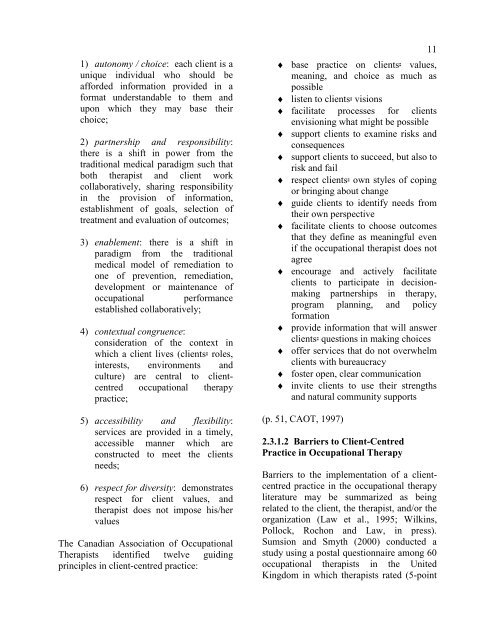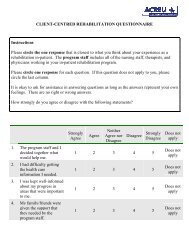Client-Centred Rehabilitation - Arthritis Community Research ...
Client-Centred Rehabilitation - Arthritis Community Research ...
Client-Centred Rehabilitation - Arthritis Community Research ...
You also want an ePaper? Increase the reach of your titles
YUMPU automatically turns print PDFs into web optimized ePapers that Google loves.
1) autonomy / choice: each client is a<br />
unique individual who should be<br />
afforded information provided in a<br />
format understandable to them and<br />
upon which they may base their<br />
choice;<br />
2) partnership and responsibility:<br />
there is a shift in power from the<br />
traditional medical paradigm such that<br />
both therapist and client work<br />
collaboratively, sharing responsibility<br />
in the provision of information,<br />
establishment of goals, selection of<br />
treatment and evaluation of outcomes;<br />
3) enablement: there is a shift in<br />
paradigm from the traditional<br />
medical model of remediation to<br />
one of prevention, remediation,<br />
development or maintenance of<br />
occupational performance<br />
established collaboratively;<br />
4) contextual congruence:<br />
consideration of the context in<br />
which a client lives (clients= roles,<br />
interests, environments and<br />
culture) are central to clientcentred<br />
occupational therapy<br />
practice;<br />
5) accessibility and flexibility:<br />
services are provided in a timely,<br />
accessible manner which are<br />
constructed to meet the clients<br />
needs;<br />
6) respect for diversity: demonstrates<br />
respect for client values, and<br />
therapist does not impose his/her<br />
values<br />
The Canadian Association of Occupational<br />
Therapists identified twelve guiding<br />
principles in client-centred practice:<br />
11<br />
♦ base practice on clients= values,<br />
meaning, and choice as much as<br />
possible<br />
♦ listen to clients= visions<br />
♦ facilitate processes for clients<br />
envisioning what might be possible<br />
♦ support clients to examine risks and<br />
consequences<br />
♦ support clients to succeed, but also to<br />
risk and fail<br />
♦ respect clients= own styles of coping<br />
or bringing about change<br />
♦ guide clients to identify needs from<br />
their own perspective<br />
♦ facilitate clients to choose outcomes<br />
that they define as meaningful even<br />
if the occupational therapist does not<br />
agree<br />
♦ encourage and actively facilitate<br />
clients to participate in decisionmaking<br />
partnerships in therapy,<br />
program planning, and policy<br />
formation<br />
♦ provide information that will answer<br />
clients= questions in making choices<br />
♦ offer services that do not overwhelm<br />
clients with bureaucracy<br />
♦ foster open, clear communication<br />
♦ invite clients to use their strengths<br />
and natural community supports<br />
(p. 51, CAOT, 1997)<br />
2.3.1.2 Barriers to <strong>Client</strong>-<strong>Centred</strong><br />
Practice in Occupational Therapy<br />
Barriers to the implementation of a clientcentred<br />
practice in the occupational therapy<br />
literature may be summarized as being<br />
related to the client, the therapist, and/or the<br />
organization (Law et al., 1995; Wilkins,<br />
Pollock, Rochon and Law, in press).<br />
Sumsion and Smyth (2000) conducted a<br />
study using a postal questionnaire among 60<br />
occupational therapists in the United<br />
Kingdom in which therapists rated (5-point








